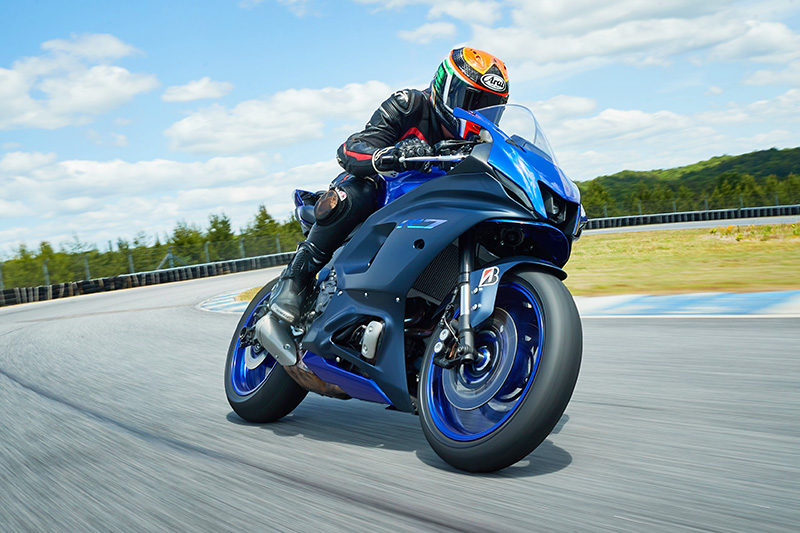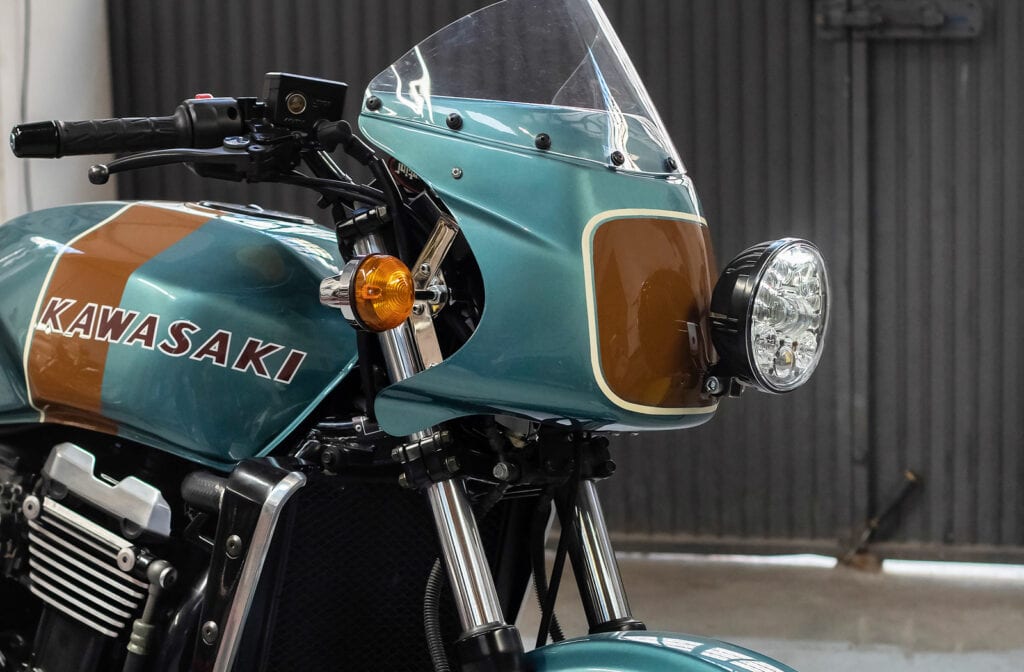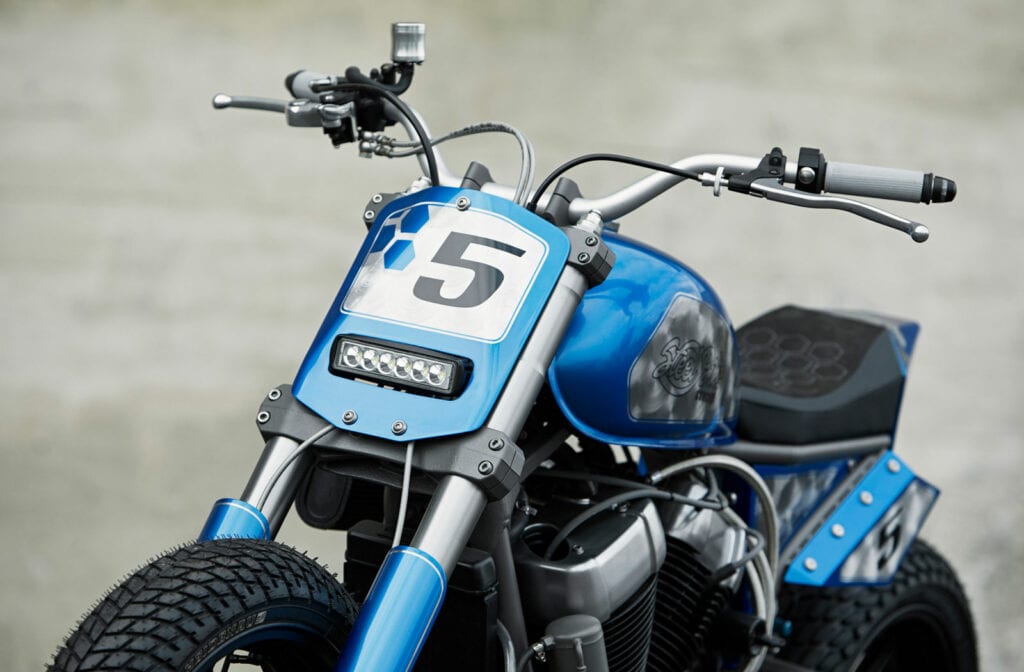What’s a rider to do if they want a supersport bike, but they don’t have the funds for a true race replica like the Yamaha YZF-R6 ($12,199) or YZF-R1 ($17,399)? Some will buy used, but doing so confidently can be a challenge, and financing may not be an option if buying from a private seller.
Yamaha’s solution is to take a proven platform — in this case, the MT-07 naked bike — and adapt it to supersport duty. Then price it within reach at $8,999.
Since the new middleweight supersport will be part of the R-series family and slot between the YZF-R3 and YZF-R1 (there’s no YZF-R6 for 2021, and the 2022 model has yet to be announced), it’s only natural to call the new bike YZF-R7. Those with a long memory may recall the 1999 YZF-R7 (aka OW-02), a 500-unit race homologation special built to compete in World Superbike. That sort of unobtainium machine is exactly what Yamaha wanted to avoid with the MT-07-based R7.
To create the YZF-R7, Yamaha made key changes to the MT-07 platform, such as new bodywork and revisions to the chassis. The 689cc CP2 parallel-twin, which has a crossplane-style 270-degree crankshaft and an uneven firing order, is a versatile motor also found in Yamaha’s Ténéré 700 adventure bike and MT-07 flat-track racer. It has usable power but not so much that it will overwhelm new or less experienced riders. For the R7, Yamaha fitted an assist-and-slipper assist clutch and a optional quick shifter, and a gearing change adds a little more acceleration and thrill into the mix.
Chassis-wise the R7 features a steeper rake (23.7 degrees vs. 24.8), slightly less trail and a shorter wheelbase (54.9 inches vs. 55.1) than the MT-07. A revised radiator improves cooling and accommodates a new fully adjustable 41mm inverted KYB fork with spring rates similar to those on the R6. The R7 also uses a smaller, lighter (by 2.4 pounds) battery like the R6. Wider triple clamps accommodate four-piston brake calipers, and offset is now 37mm compared to 40mm on the MT-07. At the rear, revised shock linkage raises rear ride height, and a new KYB shock offers adjustable spring preload and rebound damping. A rigid-mount aluminum center brace is bolted to the steel frame at the swingarm pivot for increased torsional rigidity.
With a seat that’s higher than the MT-07’s (32.9 inches vs. 31.7), clip-on handlebars, and a rider triangle inspired by the R6, the riding position is aggressive without being extreme. Compared to the MT-07, changes to the chassis and ergonomics enhance the handling capabilities of the R7, and overall it’s a comfortable, nimble motorcycle. Fresh bodywork wrapped around a compact engine and chassis make the bike every narrow and aerodynamic, like a cross between the R6 and R1, and it very much looks the part.
It’s always fun to go to a track you’ve never seen before, and it’s even better on a bike you never ridden before. Yamaha hosted the R7 launch at Atlanta Motorsports Park, a tight, hilly track with a few fast sections thrown in to make things interesting. We needed several laps to familiarize ourselves with the layout, especially with the blind corners and elevation changes. The R7’s easygoing nature was a boon for navigating the unfamiliar territory — never threatening or overwhelming, which is the point. Accessible for any level of rider.
As I rounded the track on my first few outings, I was impressed with how well the R7 worked. The riding position felt a bit high at first, but within a few laps it felt spot-on. I was able to tuck in behind the windscreen and still crawl around the cockpit easily. The R6-like front-end was excellent when entering the corners, and the chassis held steady with only a slight pitching out of the rear wheel on entry. I bottomed out a few times hitting some serious bumps, but the R7’s KTB fork took the beating in stride. That split-second thought of “Oh no!” was replaced with a “Wow, this thing is very forgiving.” Fast or slow it felt solid with exceptional feel, and the slipper clutch proved invaluable when down shifting at speed.
The new Brembo radial front master cylinder combined with Advics radial-mount 4-piston calipers and 298mm rotors allowed for some serious braking force. Out back, a Brembo master cylinder controls a Nissin caliper and a 245mm rotor. Too bad the ABS cannot be turned off. Even though ABS interference was minimal, under extreme braking I encountered more of a freewheeling sensation than I’d prefer. When I did overcook a corner, the user-friendly nature of the R7 allowed me to reel it back in.
In terms of steering, I thought the narrow position of the clip-ons might be a issue with leverage, but I was wrong. The R7 turns on dime and was effortless to maneuver in slow and fast sections of the track. Every time I pushed, it reacted like a proper sportbike. Transitioning back and forth at speed was relatively easy as the narrow chassis responds very well to input with minimal force. There are limitations, however. Even with the beefed-up chassis, the R7 felt challenged at race pace. The frame started to twist up when leaned over hard on the gas through long corners, resulting in a slight decrease in stability. The front-end started to chatter a bit off throttle mid-corner as the pace increased.
Still, none of this hampered the fun and the R7 always felt predictable. The 689cc CP2 twin was a blast on the track. I wrung its neck all day and never felt worn out. Throttle response was smooth and efficient, so I never had to worry about upsetting the chassis. The initial hit down low is good with some usable torque, but it flattens out at the upper end of the rev range. Just grab a gear via the quickshifter and you’ll have plenty more to play with.
A new LCD high-contrast instrument panel provides all the pertinent info, and the bar-graph tachometer and gear indicator, which I watch most, are easy to read. What I loved about the dash and switchgear was the lack of details and buttons for electronic riding aids. No need to fuss about which button does what. Just get on with it, and that’s exactly what we did all day long.
The 2022 Yamaha YZF-R7 is a supersport bike for the masses. More performance than an R3, but more accessible than an R1 on all fronts. The R7 could be the perfect bike for someone who wants to sharpen their skills on back roads or try their hand at club racing. Less money spent on the bike means more money available for tires — and a sticky set will last a lot longer! Yamaha has done a fine job producing a motorcycle that’s the perfect blend of accessibility and capability.
2022 Yamaha YZF-R7 Specs
Base Price: $8,999
Price as Tested: $9,199 (quickshifter)
Website: yamahamotorsports.com
Engine Type: Liquid-cooled, transverse parallel-twin, DOHC w/ 4 valves per cyl.
Displacement: 689cc
Bore x Stroke: 80.0 x 68.6mm
Transmission: 6-speed, cable-actuated assist-and-slipper wet clutch
Final Drive: O-ring chain
Wheelbase: 54.9 in.
Rake/Trail: 23.4 degrees/3.5 in.
Seat Height: 32.9 in.
Wet Weight: 414 lbs. (claimed)
Fuel Capacity: 3.4 gals.
Source link




